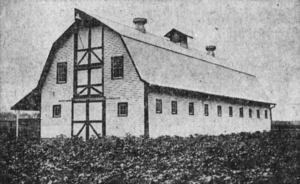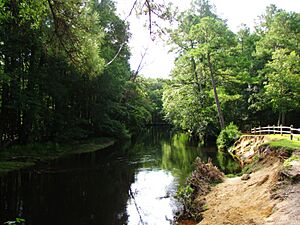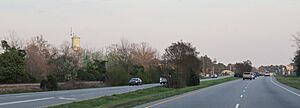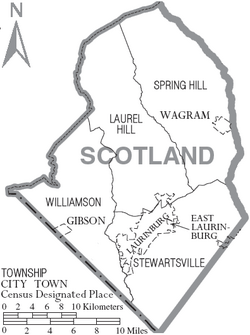Scotland County, North Carolina facts for kids
Quick facts for kids
Scotland County
|
|||||
|---|---|---|---|---|---|

Scotland County Courthouse
|
|||||
|
|||||
| Motto(s):
"Future Focused"
|
|||||
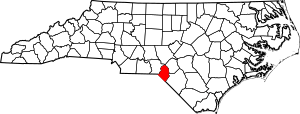
Location within the U.S. state of North Carolina
|
|||||
 North Carolina's location within the U.S. |
|||||
| Country | |||||
| State | |||||
| Founded | February 20, 1899 | ||||
| Named for | Scotland | ||||
| Seat | Laurinburg | ||||
| Largest community | Laurinburg | ||||
| Area | |||||
| • Total | 320.62 sq mi (830.4 km2) | ||||
| • Land | 319.14 sq mi (826.6 km2) | ||||
| • Water | 1.48 sq mi (3.8 km2) 0.46% | ||||
| Population
(2020)
|
|||||
| • Total | 34,174 | ||||
| • Estimate
(2023)
|
34,376 | ||||
| • Density | 107.08/sq mi (41.34/km2) | ||||
| Time zone | UTC−5 (Eastern) | ||||
| • Summer (DST) | UTC−4 (EDT) | ||||
| Congressional district | 9th | ||||
Scotland County is a county located in the southern part of North Carolina. Its main town and largest community is Laurinburg. The county was created in 1899 from a part of Richmond County. It was named to honor the Scottish settlers who came to the area in the 1700s. In 2020, about 34,174 people lived here.
The land that became Scotland County was first home to Native Americans. European settlers arrived as early as the 1720s. More people moved here after the American Revolutionary War. Scotland County was officially formed in 1899 due to political reasons. The area started to develop industries around 1900. However, it faced hard times during the Great Depression. After World War II, more industries grew as farming became more modern. In the 2000s, the county's economy struggled when textile factories closed. It also suffered during the Great Recession. The economy still faces challenges, and the county often has one of the highest unemployment rates in the state.
Contents
History of Scotland County
Early Settlers and Growth
The first people to live in what is now Scotland County were the Cheraw Native Americans. Later, Scottish Highlanders and some English Quakers began settling here. This started around the 1720s, when the area was part of the British Province of North Carolina.
Over time, North Carolina's counties were divided into smaller ones. The land that would become Scotland County was first part of Bladen County. Then it moved to Anson County. Finally, in 1779, it became part of Richmond County. Richmond County was split by the Sandhills. This made the eastern part, which would become Scotland, feel separate from the rest of the county.
More immigrants arrived after the American Revolutionary War. A large group of Scottish Highlanders came from the Cape Fear River area. They settled in two places: Johns and Laurel Hill. Laurel Hill became an important trading center after the war. Other groups, like Germans, Welsh, and English, also settled here. Enslaved Africans were also brought to the area.
In 1861, the Wilmington, Charlotte and Rutherford Railroad built a line through the area. This caused the Laurel Hill community to move south. People in the area spoke Gaelic until the 1860s.
Railroads and the Civil War
During the American Civil War, the railroad's repair shops moved to Laurinburg. This was done to protect them from Union Army attacks. But in March 1865, Union forces reached Laurinburg. They burned the railroad depot and temporary shops. The shops were rebuilt after the war, but the economy recovered slowly. Laurinburg officially became a town in 1877. It continued to grow as a railroad town until 1894, when the shops moved again.
How Scotland County Was Formed

In the late 1800s, Richmond County had many Black residents. They often supported the Republican Party. At the same time, the state of North Carolina was mostly controlled by the Democratic Party. White Democrats in Laurinburg worked to gain more political power.
Between 1893 and 1897, a lawmaker named Maxey John tried to create a new county around Laurinburg. His attempts were not successful. In the 1898 state elections, Democrats worked hard to win. They used groups like the Red Shirts to influence voters. Democrats won back control of the state government.
To thank the Democrats in Laurinburg, the state assembly created Scotland County. This happened on February 20, 1899. The new county was named to honor the Scottish settlers. Laurinburg was chosen as the county seat.
Scotland County officially began on December 10, 1900. The first courthouse was built in Laurinburg the next year. When it was created, white landowners and business people had most of the power. Black citizens were not allowed to vote again until 1928.
The county's first cotton mill opened in 1899. More textile mills were built later. A large cotton oil mill, a flour mill, and a fertilizer plant also opened. New laws in 1903 and 1909 helped the county build better roads and concrete bridges.
Challenges of the Great Depression
In the 1910s and early 1920s, more Black cotton farmers moved to Scotland County. They came from the southern states to escape problems like the boll weevil insect. Cotton production in the county was highest in 1920. Farmers also started growing fruits and melons.
The Great Depression hit Scotland County very hard. Two banks in Laurinburg closed. A state report said that one-fourth of the local people were very poor. Many small farmers lost their land. The number of non-white residents decreased. More people moved to towns.
In May 1934, 500 textile workers in East Laurinburg went on strike. They were protesting their work and living conditions. The strike made state news when a fight broke out, and nine people were hurt. The problem was later solved. The government bought some low-quality land in the Sandhills. This land was turned into a recreation area. New federal laws encouraged landowners to grow less. This meant many tenant farmers lost their jobs and moved north to find work.
World War II and Modern Times
During World War II, the U.S. government built Camp Mackall in Scotland County. This camp trained paratroopers. The Laurinburg–Maxton Army Air Base was also built to train glider pilots. About 30,000 people trained at this base. Many local people worked there, which gave them steady jobs. The base closed in 1945 and became a civilian airport.
In the 1950s, farming became more mechanized. This meant fewer farm workers were needed. People moved from rural areas to Laurinburg, Wagram, or outside the county. The population dropped by over 1,100 people between 1950 and 1960. Many farms were taken out of production. Tenant farming became much less common.
After the war, county leaders sought government money to improve local services. They wanted to attract new industries. Funds were used to build affordable housing, pave roads, and create a new hospital. The first factory owned by an outside company opened in Scotland County in 1959. A new courthouse was built in 1964. The county and Laurinburg school systems combined and became racially integrated in the late 1960s.
In the 2000s, the county's economy suffered a big setback. Many textile factories left the area. The Great Recession caused other factories to close or shrink. In July 2011, the unemployment rate reached 18.6 percent. In 2018, Hurricane Florence caused major damage to the county.
Geography and Natural Features
Scotland County is in the southeastern part of North Carolina. It sits where the Coastal Plain and Piedmont regions meet. It shares borders with Hoke, Moore, Robeson, and Richmond counties in North Carolina. It also borders Marlboro County in South Carolina.
The U.S. Census Bureau says the county covers about 320.62 square miles. Most of this (319.14 square miles) is land, and a small part (1.48 square miles) is water. It is the smallest county in North Carolina by area. The land is about 227 feet above sea level.
Scotland is one of ten counties in North Carolina's Sandhills region. The hills are mostly in the northern part of the county. The rest of the county is mostly flat. The soil is mostly sand, sandstone, and mudstone. The sandiest soils are in the Sandhills.
The far western part of the county is in the Pee Dee River area. The rest is in the Lumber River area. The Lumber River forms the county's eastern border. Many smaller streams flow through the county into the Lumber and Little Pee Dee rivers. Most of these streams are dark-colored and flow south or southeast.
The county also has hundreds of Carolina bays. These are oval-shaped wetlands. Many are in the northeast, east, and south of Laurinburg. Some of these form ponds that appear seasonally. There are also several man-made ponds.
The weather here has mild winters and hot summers. The average temperature in January is 44°F. In July, it's about 80°F. The county gets about 47 inches of rain each year. Common trees include loblolly pine, sweetgum, red maple, and water oak. Longleaf pine trees grow in the Sandhills Game Land. This is a state nature preserve that covers part of Scotland County. You might also see fox squirrels, Carolina gopher frogs, eastern tiger salamanders, and loggerhead shrikes. Parts of the Lumber River State Park are also in the county.
Population and People
2020 Census Information
In the 2020 census, 34,174 people lived in Scotland County.
- 14,402 people identified as white.
- 13,162 people identified as Black or African American.
- 3,745 people identified as American Indian.
- 343 people identified as Asian.
- 15 people identified as Native Hawaiian or Pacific Islander.
- 718 people identified as other races.
- 1,789 people identified as two or more races.
- 1,106 people identified as Hispanic or Latino.
Scotland County has the third-largest Native American population in North Carolina, making up 14 percent of its residents. Laurinburg, the largest town, had 15,024 residents.
Scotland County is part of the Fayetteville-Lumberton-Pinehurst, NC area.
Changes in Population
| Historical population | ||||||||||||||||||||||||||||||||||||||||||||||||||||||||||||||||||||
|
||||||||||||||||||||||||||||||||||||||||||||||||||||||||||||||||||||
Scotland County has always had many white, Black, and Lumbee Indian residents. The number of Hispanic residents grew in the early 2000s. From 2010 to 2020, Scotland County's population went down by about five percent. The number of residents under 18 years old dropped by 19.2 percent.
From 2017 to 2021, there were about 12,214 households in the county. Each household had an average of 2.65 people. Experts predict a 6.7 percent population drop in the county between 2020 and 2030. However, a recent report showed a small increase of 0.25 percent between 2020 and 2023.
Economy of Scotland County
Scotland County's economy is mostly based on farming. Farmers here grow corn, cotton, tobacco, and soybeans. They also raise hogs. Products from forests, like lumber and paper, are also important. After 1950, more factories opened in the county. These factories make textiles, cabinet parts, mobile homes, hospital equipment, and car parts.
Since 2000, manufacturing, especially textiles, has decreased. This has hurt the county's economy. In the early 2020s, retail businesses grew along the U.S. Route 74 area. As of 2023, the biggest job sectors are healthcare, social assistance, education, public administration, and manufacturing.
The North Carolina Department of Commerce rated Scotland as the state's second-most economically struggling county in 2024. It often has one of the highest unemployment rates in North Carolina. In September 2024, it had the highest rate at 5.6%. The average household income from 2017 to 2021 was $39,866.
Transportation in Scotland County
Scotland County will soon have two major Interstate Highways. Interstate 73 is planned to cross a small part of the county in the southwest. Interstate 74 is currently marked as Future I-74 in the county.
Current highways serving the county include:
- U.S. Route 15 (Bus.)
- US 74 (Bus.)
- US 401 (Bus.)
- US 501
- North Carolina Highway 71
- NC 79
- NC 44
- NC 381
The county government supports a public transport bus service called the Scotland County Area Transit System. For air travel, there is the Laurinburg–Maxton Airport. Local trains are run by CSX Transportation and the Laurinburg and Southern Railroad. The longest straight stretch of railroad track in the United States is 78.86 miles long. It connects Wilmington to Old Hundred in Scotland County.
Education in Scotland County
Scotland County Schools manages the public schools in the area. As of 2023, the school system has 10 schools and serves 5,592 students. In 2021, the school district was rated as low-performing. However, its ranking improved in 2022.
The county also has a branch campus of Richmond Community College. St. Andrews University, a private liberal arts school, is also located here. According to a 2021 survey, about 15.3 percent of county residents have a bachelor's degree or higher.
Healthcare in Scotland County
Scotland County has one hospital, Scotland Health Care System, located in Laurinburg. In 2022, a health ranking report placed Scotland County 98th out of North Carolina's 100 counties for health outcomes. The report found that 28 percent of adults say their health is poor or fair. The average life expectancy in the county is 73 years. Also, 14 percent of people under 65 do not have health insurance.
Culture and Traditions
Many family names, street names, and places in Scotland County show its Scottish roots. Since 2008, the county has held an annual Scotland County Highland Games festival. This event celebrates the strong Scottish heritage of the people living here.
The sports teams at Scotland County High School are called the Fighting Scots. The school's marching band wears traditional Scottish clothing. This includes kilts, sporrans (pouches), plaid shawls, and Glengarry bonnets (hats). The county also hosts an annual Kuumba festival. This event celebrates African American heritage.
Several buildings and sites in the area are listed on the National Register of Historic Places. Religion is an important part of community life. Fishing is also a popular fun activity.
Communities in Scotland County
City
- Laurinburg (county seat and largest community)
Towns
Townships
- Laurel Hill
- Spring Hill
- Stewartsville
- Williamson
Census-designated places
Unincorporated communities
Images for kids
See also
 In Spanish: Condado de Scotland (Carolina del Norte) para niños
In Spanish: Condado de Scotland (Carolina del Norte) para niños




